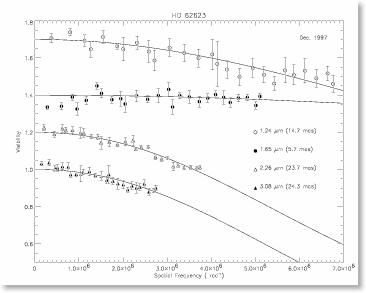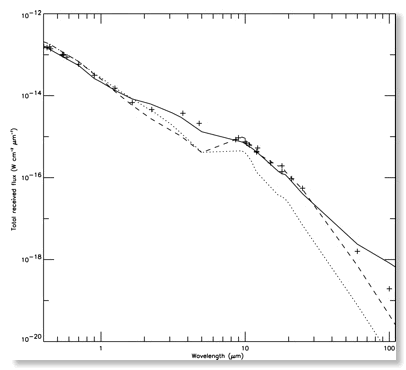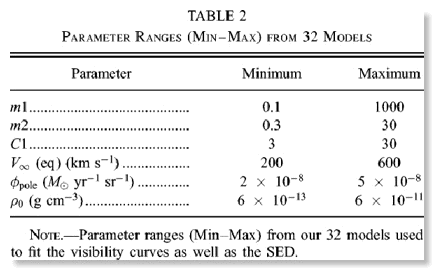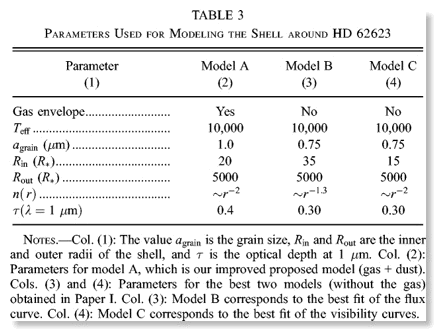B[e] stars are hot peculiar star showing an important excess in the near infrareddue to the presence of hot circumstellar dust around. B[e] stars show also forbidden lines in its spectrum. The geometry of the dust enveloppe around these stars seems to be uncertain. Zickgraf et al. (1985) proposed a model for the B[e] supergiant R126 consisting of a fast wind in the polar regions and a dense and slow wind in the equatorial region where the dust is formed. Using SIMECA, a model developped for classical Be stars (Stee et al. 1994, 1995), Stee (1998) investigated the shape of the envelope around B[e] supergiant stars. He found that winds from B[e] stars can be so dense that they become optically thick in the continuum, masking the photosphere of the central star. These results are presented in the paper: Stee 1998 A&A, 336, 980
Observations of the peculiar star HD 62623 at the Keck telescope with the aperature masking inteferometry (Tuthill et al. 2000) showed an envelope that seems partially resolved in the near infrared except at 1.65 μm
as shown in the following figure (Bittar et al. A&A, 368, 197). Using a radiative transfer model for dust in a spherical envelope developed by Lopez et al. (1993, 1995) we tried to reproduce the visbility curves obtained at the Keck and we showed how important is the constraint brought by the high angular resolution observation on the modeling of the peculiar B[e] stars. A next generation model (SIMECA II) will be dedicated to the case of the B[e] stars. Based on the scheme of Zickgraf et al. (1984), this model assumes the central star as a classical Be star with two quite distinct regions in the circumstellar envelopes. The thermal infrared excess is most probably produced in the outer parts of the equatorial region or equatorial disk where the temperature allows the formation of dust grains.

Visibility curves obtained at the Keck I telescope for the star
HD~62623 and plotted as a function of baseline length by performing an azimuthal
average. The graph corresponds to observations obtained in Decembre
1997 for four wavelengths. Constant offsets have been added to the various
colors to separate them on the plot. The offset is a visibility of +0.3
for the 1.24 μm and of +0.2 for the other wavelengths. The visibilities
are scaled so that the Gaussian fits models passed through a visibility = 1 at 0 spatial frequency.
From Bittar et al. A&A, 368, 197
In "A Gas + Dust Model of the Peculiar Envelope of HD 62623 Based on Interferometric Observations" 2004, ApJ, 602, 978 we present an improved model for the circumstellar environment of the peculiar star HD 62623 taking into account the gas around the central star and the dust present in the outer parts of the envelope. We compare our results with photometric observations and near-infrared interferometric observations obtained with aperture masking interferometry performed at the Keck I telescope from the literature. This modeling has two goals: to provide a framework for understanding the partially resolved object shown by the visibility curves, and to allow investigation of the envelope of HD 62623 by discrimination between proposed models.

Total received flux (star with or without its circumstellar envelope of gas + scattered flux + thermal emission) compared to the observations (crosses). Dashed and dotted lines are for model B and C, i.e., for a blackbody central star without gas, whereas the plain line is for model A, i.e., for a star with its circumstellar gas envelope (see Table 3 for details about the different models corresponding to A, B and C).
We show that a better fit for both the photometric and interferometric data is obtained by adding the gas in the inner part of the envelope. The present model allows us to confirm a smaller value for the inner dust radius, i.e., Rin = 1520 R*. The dust temperature we obtain at this boundary is Tin = 1500 K. Our simulation seems to indicate that, even with a nearly spherical model, a sufficient density ( 10-18 g cm-3) to form dust at the inner radius is obtained.

Despite our multiple tentatives, we were not able to reproduce the visibility curve at 1.65 m showing an unresolved object. At 1.24, 2.26, and 2.08 m, the agreement between our best model and the visibility data is not good enough to draw a very strong conclusion, but it may indicate that the circumstellar environment of HD 62623 is based on different grain sizes and optically thick dust.
